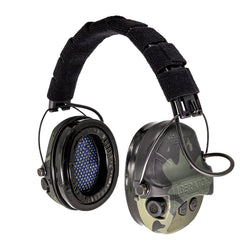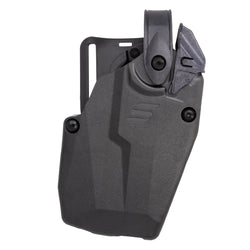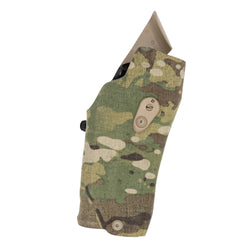Over 20 years ago, only a handful of companies existed that offered backcountry hammocks. I know this because, like many of you, I’m obsessive when it comes to researching gear before making a decision. Fast forward to the present day, and you’ll find countless hammocks for all body shapes, tandem campers, and accessories that extend the hammock camping season to all twelve months.
There is no doubt hammock camping has taken off, but there are still some reluctant to get off the ground. Perhaps this hesitation comes from inexperience, bad advice, or stories heard. If sound advice is followed, it is easy to become a tree dweller for the best night’s sleep.

The Arguments For
I decided to hammock camp for the first time after waking up in a puddle on a survival camping trip to the Adirondacks. While my sleeping bag stayed somewhat warm when wet, the discomfort was enough to make me look for alternative shelters.
One of the benefits of a good hammock is the fact that the ground conditions don’t matter. A hammock can be set up over roots, rocks, uneven terrain, and even water. Hammocks also provide greater visibility of surroundings, better air flow in the hottest conditions, and typically less bulk to carry since tent poles are not necessary. As long as a hammock has two secure anchor points, it can be suspended from just about anything, anywhere. The average hammock camper will use a hammock for two or three seasons of the year.

The great ventilation hammocks provide in the summer becomes the downfall of the hammock when the mercury drops. Despite cold weather, the most hardened hammock campers can add an underquilt to their setup that extends their use year-round. This, paired with heavy socks, waffle-knit base layers, and a watch cap, and you’ll sleep comfortably.
Hammocks also provide you with freedom. If you are used to camping with someone who snores, you can hang your hammock away from them and give yourself some standoff from the obnoxious chainsaw sounds they make.
The Components
There are some very elaborate hammock camping setups, and getting lost in all of the accessories is a real possibility. At the very core, a hammock consists of the hammock body, the suspension straps, and a tarp or cover sheet overhead.
From the survival perspective, a quality shelter consists of what you sleep inside, over, and under (I.O.U.). The basic components of a hammock address the over and under, to an extent, but adding a bug net and a simple ground pad will increase your comfort.
The hammock body is typically made from nylon and can be sized for the most petite to the most husky. The length of the hammock matters. Look for one about two feet longer than your height.
Suspension straps can be daisy-chain style with multiple attachment loops or adjustable with rugged yet lightweight buckles that will hold a hammock equally secure.
The final component to the hammock system is a large tarp. This can be configured in an A-frame or diamond, typically.

From these three, hammock, suspension, and tarp, refinements can be customized to the individual’s needs. Lightweight cordage, longer ground stakes for the tarp, metal clips for faster setup and takedown, and other options make the sky the limit.

The Basic Hang
The most basic hang you can find would consist of suspending the hammock from two sturdy living trees with no widowmakers above.
Widowmakers are tree branches or dead standing trees that could dislodge and fall on you in camp. They are one of the five “W’s” with the other four considerations being “wood”, “water”, “wind”, and “wiggles.”
When looking for the optimal angle of suspension straps to the ground, 30 degrees is typically agreed upon as such. Your tarp should be suspended over your hammock with the hammock body completely covered.

You can add in small strands of paracord on your suspension to serve as drip rings that will make any precipitation fall off your suspension straps before it reaches you.
My personal preference is to use a tarp in a diamond configuration a few feet high above my hammock in the summer, and an A-frame configuration closer to the hammock in cooler months. The tarp would have tautline hitches tied into the guy lines to adjust for height, and if there is a cooling breeze, I’ll prop up one side of the diamond with a small sapling or branch.

The Pro Tips
It is said, “experience is a great teacher,” and with two decades of hammock use, I have a few pointers to share in rapid-fire format.
- Mark your hammock head area to distinguish it from your feet.
- Place a small tarp or cloth down at your feet to stand on in the morning as a landing pad.
- Use small keychain snap links to suspend your kit at the end of your hammock to keep it off the ground in buggy territory.
- Keep certain items within reach inside the hammock pockets and put the rest in small ditty bags nearby.

- Always change into a dry layer of clothes before going to sleep at night, and only use this dry “sleep suit” for that activity.
- Pack suspension extension straps made from half-inch flat webbing to help you reach anchor points for your hammock.
- Wear a chest rig to sleep to keep your chest warmer in cooler weather.
- A grab loop clipped into your hammock suspension will help you pull yourself up if you slide down in the middle of the night.

- Set up your tarp first and get in this habit to provide yourself some protection from the rain if it is coming down when you arrive in camp.
- Always test your hammock for strength before fully trusting it with all of your weight.
- Try to sleep diagonally across your hammock instead of letting it fold your shoulders together.
- Treat your hammock with permethrin insect repellent to keep the mosquitoes and flies from biting you through it.
- Be prepared for using the hammock on the ground. You may not find ideal conditions to suspend it, but you can still use the pieces on the ground as a bivy sack.
- Insulation in your hammock matters, and many will use a quilt rather than a traditional sleeping bag. Sleeping bags can be used, and the center zip is the easiest to get in and out of.

Getting Started
Rather than diving headfirst into hammock camping, start small and build up your confidence in the system.
Some hammock manufacturers allow you to purchase individual components, avoiding the need to drop a huge chunk of change to experiment with an unknown. With just the hammock body and straps, which can be found on social media marketplaces and discount stores, you can get a feel for sleeping in a hammock in your backyard first.

Start with an afternoon nap and build trust from the security of your home turf. Pack that hammock and strap set next time you go to the beach or lake and see how it provides a great place to kick up your feet. From there, use it on a single overnight trip and pack your usual tent as a backup in case you can’t make it a full night’s sleep.
Before you know it, these baby steps will lead to you selecting your hammock more often than not. You’ll be among the ranks of the tree dwellers, and the thought of sleeping on the ground won’t appeal to you anymore.









